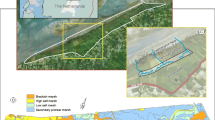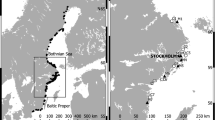Abstract
We studied the impact of livestock grazing on the distribution ofBranta bernicla bernicla (Dark-bellied Brent goose) in the Dutch Wadden Sea during spring. It was hypothesized that livestock facilitate short-term (within-season) grazing for geese as well as long-term (over years). Therefore we measured grazing pressure by geese in salt marsh and polder areas that were either grazed (spring-grazed) or ungrazed during spring (summer-grazed). Additionally, we carried out a preference experiment with captive geese to test the preference between spring-grazed and summer-grazed polder swards. We furthermore compared patterns of use by geese between long-term ungrazed and grazed salt marshes.
In May, there is a difference in grazing pressure by geese between polder pastures that are grazed or ungrazed during spring. In this month, the ungrazed polder pastures are abandoned and the geese shift to either the grazed polder pastures or to the salt marsh. Vegetation in the polder that had been spring-grazed had a lower canopy height and a higher tiller density than summer-grazed vegetation. The captive geese in the preference experiment showed a clear preference for vegetation that had been spring-grazed by sheep over ungrazed vegetation. Goose grazing pressure was negatively correlated to canopy height, both on the polder and on the salt marsh. Within the plant communities dominated byFestuca rubra andPuccinellia maritima, marshes that were intensively grazed by livestock generally had higher grazing pressure by geese than long-term ungrazed or lightly grazed salt marshes.
Similar content being viewed by others
References
Aerts, B.A., Esselink, P. & Helder, G.J.F. 1996. Habitat selection and diet composition of Greylag geeseAnser anser and Barnacle geeseBranta leucopsis during fall and spring staging in relation to management in the tidal marshes of the Dollard.Z. Ökol. Natursch. 5: 65–75.
Andresen, H., Bakker, J.P., Brongers, M., Heydemann, B. & Irmler, U. 1990. Long-term changes of salt marsh communities by cattle grazing.Vegetatio 89: 137–148.
Bakker, J., Bos, D. & de Vries, Y. 2003. To graze or not to graze, that is the question. In: Essink, K., van Leeuwe, M., Kellerman, A., & Wolff, W. (eds.)Proceedings of the 10th International Scientific Wadden Sea Symposium, pp. 67–88. Ministry of Agriculture, Nature Management and Fisheries, The Hague, NL.
Bergmann, H. & Borbach-Jaene, J. 2001.Abschlussbericht des Forschungsprojektes Auswirkungen von Bewirtschaftung sänderungen auf die Habitatwahl, Raumnutzung und das Verhalten von Nonnengans und Ringelgans am Beispiel der Levbucht im Nationalpark Niedersächsisches Wattenmeer. Universität Osnabrück, Osnabrück, DE.
Bos, D. 2002.Grazing in coastal grasslands: Brent geese and facilitation by herbivory. Ph.D. Thesis, University of Groningen. URL: http://www.ub.rug.nl/eldoc/dis/science/d.bos/
Boudewijn, T. 1984. The role of digestibility in the selection of spring feeding sites by Brent geese.Wildfowl 35: 97–105.
Demment, M.W. & van Soest, P.J. 1985. A nutritional explanation for body-size patterns of ruminant and nonruminant herbivores.Am. Nat. 125: 641–672.
Drent, R. & van der Wal, R. 1999. Cyclic grazing in vertebrates and the manipulation of the food resource. In: Olff, H., Brown, V. & Drent, R. (eds.)Herbivores between plants and predators, pp. 271–299. Blackwell Science, Oxford, UK.
Ebbinge, B. & Boudewijn, T. 1984.Richtlijnen voor het beheer van rotganzen in het Nederlandse wadden gebied. Rapport 84/4. Rijksinstituut voor Natuurbeheer, Leersum, NL.
Ebbinge, B.S. & Spaans, B. 1995. The importance of body-reserves accumulated in spring staging areas in the temperate zone for breeding in Dark-bellied Brent geesBranta b. bernicla in the high Arctic.J. Avian Biol. 26: 105–113.
Fox, A.D., Kristiansen, J.N., Stroud, D.A. & Boyd, H. 1998. The effects of simulated spring goose grazing on the growth rate and protein content ofPhleum pratense leaves.Oecologia 116: 154–159.
Hassall, M., Riddington, R. & Helden, A. 2001. Foraging behaviour of brent geese,Branta b. bernicla, on grasslands: effects of sward length and nitrogen content.Oecologia 127: 97–104.
Hik, D.S. & Jefferies, R.L. 1990. Increases in the net above-ground primary production of a salt-marsh forage grass; a test of the predictions of the herbivore-optimization model.J. Ecol. 78: 180–195.
Hutchings, N.J. & Gordon, I.J. 2001. A dynamic model of herbivore-plant interactions on grasslands.Ecol. Mod. 136: 209–222.
Jensen, A. 1985. The effect of cattle and sheep grazing on salt-marsh vegetation at Skallingen, Denmark.Vegetatio 60: 37–48.
Kersten, M., Rappoldt, K. & van Scharenburg, K. 1997. Wadvogels op Ameland. In: Versluys, M., Engelmoer, R., Blok, D. & van der Wal, R. (eds.)Vogels van Ameland, Friese Pers Boekerij bv, Leeuwarden, NL.
Kiehl, K., Eischeid, I., Gettner, S. & Walter, J. 1996. Impact of different sheep grazing intensities on salt marsh vegetation in northern Germany.J. Veg. Sci. 7: 99–106.
Madsen, J., Cracknell, G. & Fox, A.D. 1999.Goose populations of the Western Palearctic. A review of the status and distribution. Wetlands International, Wageningen. National Environmental Research Institute, Rønde, DK.
Mayhew, P. & Houston, D. 1999. Effects of winter and early spring grazing by WigeonAnas penelope on their food supply.Ibis 141: 80–84.
McNaughton, S.J. 1979. Grazing as an optimization process: grass-ungulate relationships in the Serengeti.Am. Nat. 113: 691–703.
Norris, K., Brindley, E., Cook, T., Babbs, S., Forster Brown, C. & Yaxley, R. 1998. Is the density of redshankTringa totanus nesting on saltmarshes in Great Britain declining due to changes in grazing management?J. Appl. Ecol. 35: 621–634.
Olff, H., de Leeuw, J., Bakker, J.P., Platerink, R.J., van Wijnen, H.J. & de Munck, W. 1997. Vegetation succession and herbivory in a salt marsh: Changes induced by sea level rise and silt deposition along an elevational gradient.J. Ecol. 85: 799–814.
Prins, H.H.T. & Ydenberg, R.C. 1985. Vegetation growth and a seasonal habitat shift of the barnacle goose (Branta leucopsis).Occologia 66: 122–125.
Prop, J. & Black, J.M. 1997. Food intake, body reserves and reproductive success of barnacle geeseBranta leucopsis staging in different habitats. In: Mehlum, F., Black, J. & Madsen, J. (eds.)Proceedings of the Svalbard Goose symposium, pp. 175–193. Norsk-Polarinstitutt, Oslo, NO.
Riddington, R., Hassall, M. & Lane, S.J. 1997. The selection of grass swards by brent geeseBranta b. bernicla: Interactions between food quality and quantity.Biol. Conserv. 81: 153–160.
Roozen, A.J.M. & Westhoff, V. 1985. A study on long-term salt marsh succession using permanent plots.Vegetatio 61: 23–32.
Schaminée, J., Weeda, E. J. & Westhoff, V. 1998.De Vegetatie van Nederland. Vol. 4: Plantengemeenschappen van de kust en van binnenlandse pioniermilieus. Opulus Press, Uppsala, SE.
Spaans, B. & Postma, P. 2001. Inland pastures are an appropriate alternative for salt-marshes as a feeding area for spring-fattening Dark-bellied Brent geeseBranta bernicla.Ardea 89: 427–440.
Stock, M. & Hofeditz, F. 2000. Der Einfluss des Salzwiesen-Managements auf die Nutzung des Habitates durch Nonnen- und Ringelgänse. In: Stock, M. & Kiehl, K. (eds.)Die Salzwiesen der Hamburger Hallig, pp. 43–55. Landesamt für den Nationalpark Schleswig-Holsteinisches Wattenmeer, Tönning, DE.
Summers, R.W. & Critchley, C.N.R. 1990. Use of grassland and field selection by Brent geeseBranta bernicla.J. Appl. Ecol. 27: 834–846.
van de Koppel, J., Huisman, J., van der Wal, R. & Olff, H. 1996. Patterns of herbivory along a productivity gradient: An empirical and theoretical investigation.Ecology 77: 736–745.
van der Meijden, R. 1990.Heukels' Flora van Nederland. Wolters-Noordhoff, Groningen, NL.
van der Wal, R., van de Koppel, J. & Sagel, M. 1998. On the relation between herbivore foraging efficiency and plant standing crop: An experiment with barnacle geese.Oikos 82: 123–130.
van der Wal, R., van Lieshout, S., Bos, D. & Drent, R.H. 2000. Are spring staging brent geese evicted by vegetation succession?Ecography 23: 60–69.
van Wijnen, H. & Bakker, J.P. 1997. Nitrogen accumulation and plant species replacement in three salt marsh systems in the Wadden Sea.J. Coastal Conserv. 3: 19–26.
Vickery, J.A., Sutherland, W.J. & Lane, S.J. 1994. The management of grass pastures for brent geese.J. Appl. Ecol. 31: 282–290.
Zar, J. 1996.Biostatistical analysis. Prentice-Hall, Inc., New York, NY.
Author information
Authors and Affiliations
Corresponding author
Rights and permissions
About this article
Cite this article
van der Graaf, A.J., Bos, D., Loonen, M.J.J.E. et al. Short-term and long-term facilitation of goose grazing by livestock in the Dutch Wadden Sea area. J Coast Conserv 8, 179–188 (2002). https://doi.org/10.1652/1400-0350(2002)008[0179:SALFOG]2.0.CO;2
Received:
Revised:
Accepted:
Issue Date:
DOI: https://doi.org/10.1652/1400-0350(2002)008[0179:SALFOG]2.0.CO;2
Keywords
- Barnacle geese
- Branta bernicla bernicla
- Branta leucopsis
- Dark-bellied Brent goose
- Herbivory
- Polder
- Salt marsh
- Succession




